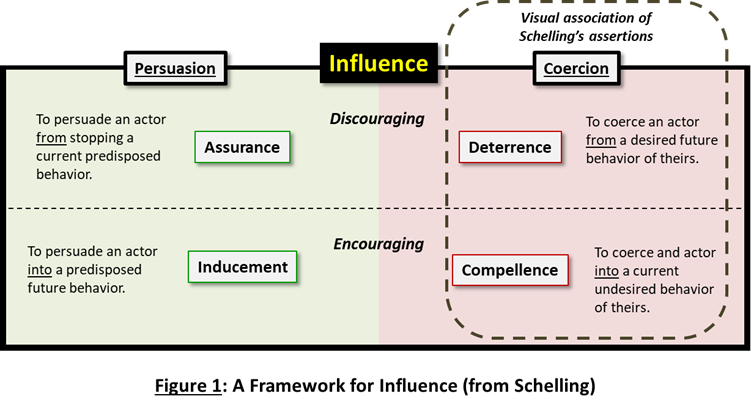Coercion Theory: A Basic Introduction for Practitioners

Coercion Theory: A Basic Introduction for Practitioners by Tami Davis Biddle | Texas National Security Review Vol 3, Iss 2 | 94–109
Below is a brief survey of this article. Please read the full piece for a deeper dive into Coercion Theory.
For more information on Coercion Theory and Thomas Schelling’s seminal work, read Influence Mechanisms: A Framework for Integrated Operations by Adam Reitz | Small Wars Journal 9.15.2021
The Foundational Disconnect in Coercion Theory
This analysis by Tami Davis Biddle addresses a critical disconnect between the academic understanding of coercion theory and its application by military practitioners. She stresses that a clearer, more systematized language of coercion is essential for effective civil-military communication, national strategy, and successful military outcomes. Thomas Crombie Schelling’s seminal 1966 work, Arms and Influence, is widely regarded as the cornerstone of modern coercion theory, which explores the strategic logic behind threats, the use of force, and warfare.
Practitioner Perspectives and Doctrinal Inconsistencies
Military professionals often approach coercion theory with skepticism, viewing academic concepts as detached from the realities of war. They may find the idea of violence as a “bargaining process” uncongenial and struggle with the notion that coercion necessitates some form of enemy cooperation. The term “coercion” itself can carry negative connotations of blackmail or manipulation and the emphasis on “threatening” can be at odds with their self-identity. This conceptual friction is exacerbated by inconsistencies in military doctrine, where terms like “annihilation” and “erosion” are used, imperfectly aligning with Schelling’s fundamental categories of “brute force” and “coercion.” This leads to potential miscommunication and strategic miscalculations.
Schelling’s Taxonomy: Coercion, Deterrence, Compellence, and Brute Force
Schelling’s framework distinguishes between “coercion” and “brute force.” Coercion, an overarching category encompassing “deterrence” and “compellence,” relies on the ability to inflict future pain, thereby manipulating an adversary’s incentives to achieve a desired behavior. It involves making a threat to do something not yet done, forcing the target to calculate whether resisting the threat is preferable to complying. Deterrence aims to prevent an adversary from initiating an action, while compellence seeks to make an adversary perform an action or cease one already in progress. Both forms fundamentally depend on the adversary’s decision and, therefore, their cooperation. In contrast, “brute force,” or “forcible action,” is applied directly to obviate choice, making the enemy helpless to resist by physically destroying their capabilities without requiring their decision.
Operationalizing Coercion: Methods and Inherent Difficulties
Coercion can be achieved through threats of punishment or denial. Punishment involves inflicting pain for non-compliance, such as air strikes or blockades. Denial aims to dissuade an adversary by convincing them that their military objectives will fail. The effectiveness of coercion, particularly compellence, is inherently challenging, with historical success rates often around 35 percent. This difficulty stems from the fact that the target state ultimately retains the initiative to comply or resist. Successful coercion demands precise communication, ensuring the adversary understands the demands and believes that compliance will cease the pain, while resistance will prolong it. This necessitates deep intelligence into the target state’s fears, vulnerabilities, and interests, as well as the coercer’s own commitment to the stake.
Military Instruments and the Dynamics of Escalation
Military instruments play distinct roles within this framework. Airpower and naval forces are often employed for punishment and can aid in denial. However, land power holds a unique position in the realm of brute force, as it can ultimately control the ground and remove existing leadership, thereby dispensing with the need for adversary cooperation. The concept of “escalation dominance” is crucial, implying the ability to increase threatened costs while denying the adversary the means to negate them or counter-escalate. While nuclear weapons represent the pinnacle of escalation, conventional land power provides maximum escalatory range below the nuclear threshold, offering a potent coercive tool when other leverage fails.
Challenges for Democracies and the Enduring Value of Coercion Theory
Democracies face particular challenges in employing coercion due to multiple power centers and diverse interest groups, which can complicate clear communication and consistent messaging. Political decision-makers may also underestimate the costs and complexities of land campaigns, especially the post-hostilities phase. Despite these challenges, coercion theory remains an invaluable asset for national security strategists, particularly in an era of renewed international competition. It compels planners to rigorously assess assumptions, understand the enemy’s will, and realistically evaluate the costs of their choices, reinforcing the timeless wisdom of strategists like Sun Tzu and Clausewitz.






